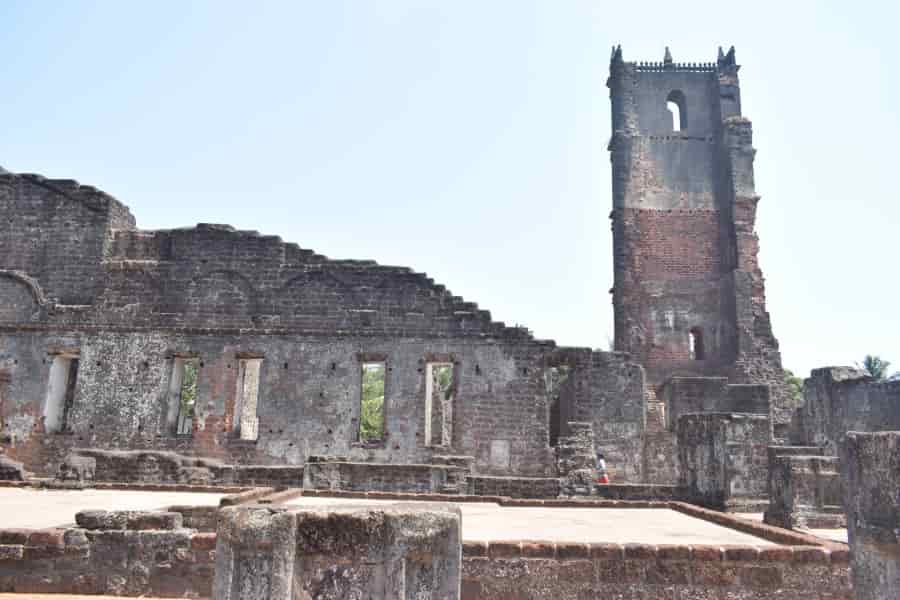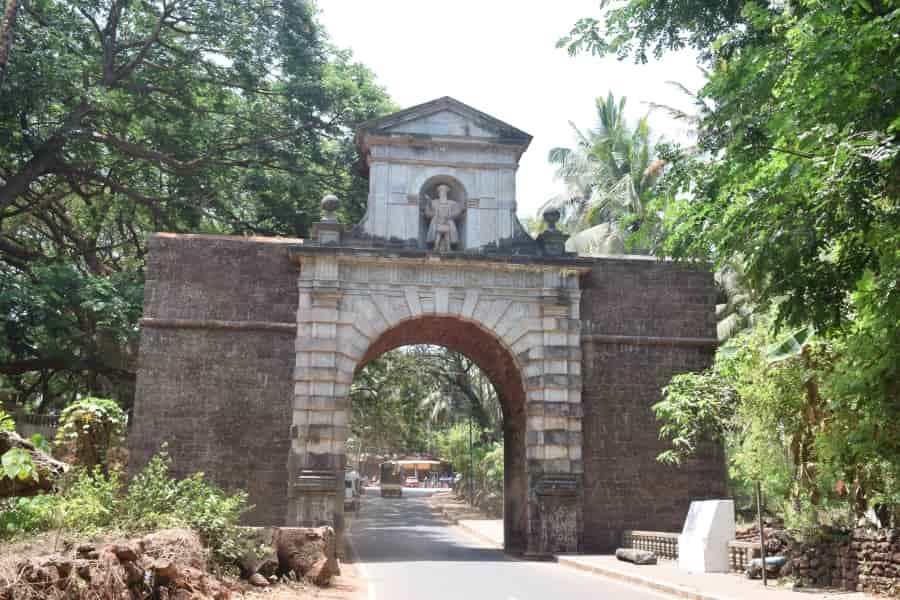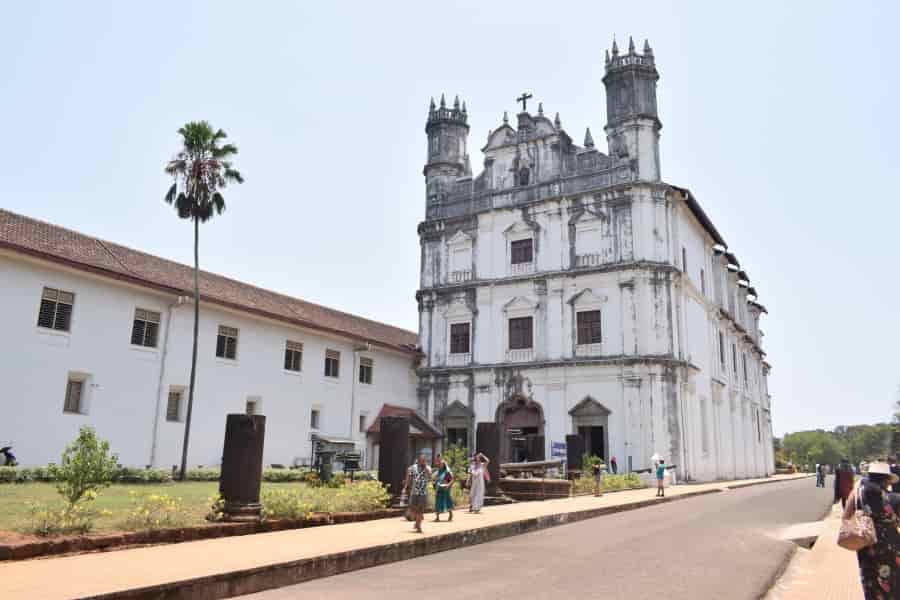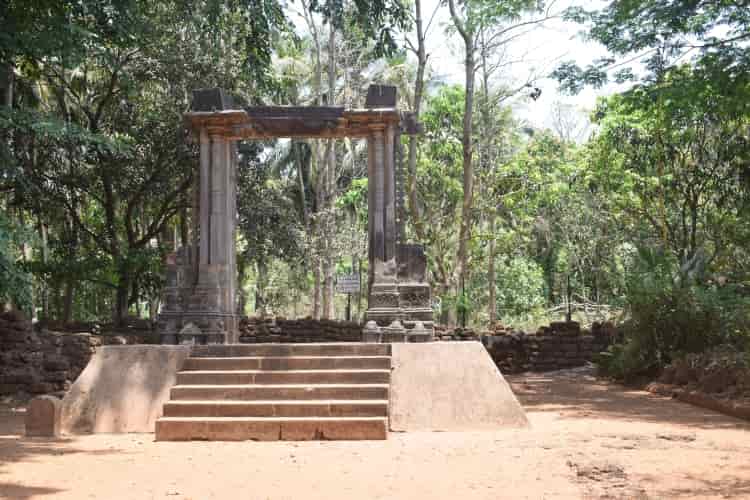Last Updated on April 9, 2020 by Augustin Fernandes

The city Old Goa was founded in the 15th century as a port on the banks of the Mandovi river by the Bijapur Sultanate. The place is known as Saibachem Goem, Pornnem Goem, Adlem Goem or just Goem in Konkani
Old Goa has a number of the oldest and beautiful Churches in Goa and India. Some of the churches here are huge and all closely located to one another.
A trip down to Old Goa is breath-taking as you will see some beautiful architecture and artistry while seeing these magnificent pieces of work. Being the capital of Goa under the Portuguese Old Goa was the major city of development for the Portuguese and hence holds some of the most historic churches within its boundaries.
1. Old Goa Church – Basilica of Bom Jesus Old Goa

Old Goa Church is one of the most beautiful examples of baroque architecture seen in India. The church signifies the mark that the Portuguese had in Goa and is also known to be the unique of all the Goan Churches.
Church Structure and History
The entrance to the church is quite spectacular as you enter a beautifully ornamented door that leads you onto a marble stone floor inlaid with precious stones.
It is a large single Nave structure built between 1595 to 1605. It is the only Church with a façade not covered with plaster. The plaster was stripped off in 1970 by an over-zealous Portuguese conservationist who believed that this would help preserve the carvings on the façade better. Unfortunately, even though this was soon seen to be a false assumption, no one has put the plaster back
The baroque architecture of the building combined with the beautiful carvings and woodwork gives you a picturesque welcome.
Body of St Francis Xavier
What makes this Church special to the Goans and the tourists in particular, is the fact that it’s a sacred monument that holds the body of the famous Portuguese Saint: “St. Francis Xavier”.
Every year on the 3rd of December, the Basilica of Bom Jesus celebrates the feast of St. Francis Xavier.
The feast is witnessed by Christians as well as non-Christians alike and is open to the general public. It’s a place where Goans from different cultures unite together to celebrate the holiness of their land.
Church Timing: 9:00 am to 6:30 pm
Fees: Free
2. Augustine Church Goa – Historical landmark in Goa

St. Augustine Church was once the most remarkable Church in Goa and India, seen standing proudly on the hill of Monte Santo.
This magnificent piece of ancient architecture was the site of the monastery of the Augustinian order, which was attached to the enormous church of Nossa Senhora da Graca (Our Lady of Grace).
St. Augustine Church is declared as a world heritage site in 1986, the ruins of this church now attract tourists from around the world, who visit the site with sheer delight at the sight of this magnificent tower which remains standing tall till today.
History of St. Augustine Church Goa
St. Augustine Church Goa originally consisted of a complex combining a chapel along with a convent, with dining rooms, all built by the friars of the First Augustinian Order, who arrived in Goa in the year 1572.
The Church and its surroundings were initially built with the locally available stone known as ‘laterite stone.’ The initial building of the Church was massive in size and was almost forty-six meters in height having four stories.
The famous ‘Tower’ which remains today was meant to serve as a belfry, and the Church had eight richly adorned chapels and four altars and a convent with numerous cells attached to it.
The construction of this magnificent masterpiece began more than 400 years ago and was finished between the years 1597 to 1602. The main architectural genius behind the making of the St. Augustine Church is said to be an Italian person. Read More
3. Se Cathedral Old Goa – UNESCO World Heritage Site

Se Cathedral Church of Old Goa is one of the oldest and biggest churches to be seen in Asia.It is dedicated to Senta Catarina.
The construction of this magnificent masterpiece began in 1562 and was completed in the year 1619. It was built by the Portuguese, under the famous Portuguese general and statesman; Afonso de Albuquerque, who was considered by the Portuguese, to be somewhat of a military genius.
The Portuguese built the Church as a ‘celebration’ and a mark of ‘authority’ to themselves after they had defeated the Muslim rule in Goa.
The Architecture of Se Cathedral
This architectural masterpiece of what is known to be ‘Se Cathedral,’ is declared to be one of the world heritage sites of UNESCO. The architecture itself is one of the reasons why people stand still to catch a breath, as they look on with awe, at this beautiful creation.
The Architecture style is Portuguese – Manuelin. The exterior of the church is a design of Tuscan ( an Italian form of architecture), and the interior is that of Corinthian ( an ancient Greek and Roman form of architecture ). The main architect behind the spectacular overall design of the Church was said to be an engineer called, Juliao Simao.
Church Timing: 7:00 am to 6:30 pm
Fees: Free
4. Church of St. Cajetan Old Goa

This church of St. Cajetan was said to have modelled the original design of the Basilica of St.Peter in Rome. The Church was initially dedicated to Our Lady of Divine Providence and is commonly known as the Church of St. Cajetan.
Structure of Church of St. Cajetan
The Church of St. Cajetan is built in an architecturally Corinthian style, both externally and internally while the gilded altars with rich carvings are in rich Baroque style. The Church building is built of laterite blocks which are lime plastered.
This church was built by Italian Monks of the Order of Theatines in 1665. The church exhibits a crown with a huge hemispherical dome. The design is said to be the pattern of the Roman Basilica of St. Peter.
The façade of this church exhibits superb examples of Corinthian architecture. Four statues of St. Paul, St. Peter, St. John the Evangelist and St. Matthew are hidden within its walls. Read More
Also Read
Goa Travel Tips – Must Read before visit Goa
5. Chapel of St. Catherine Goa

The Chapel of St. Catherine old Goa is part of the “UNESCO World Heritage Site” of Churches & Convents in Goa. It was built by Alfonso De Albuquerque in 1510 when he defeated the local Muslim ruler Adil Shah. That day in history was named the St. Catherine’s Day, on 25th November 1510.
Unlike most other pure white structures in Goa, the Chapel of St. Catherine has been built with a color of brown and white in its facade. As a visitor, it would be interesting to take note of the fact that the Se Cathedral, the Church of St. Francis of Assisi, the Archaeological Museum, the Portrait Gallery and the Chapel of St. Catherine, stretching from the east to the west are all situated in the same compound and are all maintained by the Archaeological Survey of India.
Structure of Chapel of St. Catherine
The structure of the St. Catherine Chapel has a tower on either side of its facade, and the interior is plain with only an altar. On one side of the Chapel is a stone inscription in Portuguese. The Chapel has rectangular window panes of Old Portuguese styled dressed in mica shells. As you enter the chapel, you will see a statue of Our Lady. Read More
6. Archeological Museum of Goa

The convent, adjoining the church of St. Francis of Assisi, was converted into a museum and was set up by the Archaeological Survey of India in 1965. The museum contains artifacts, paintings, and sculptures that showcase Goa’s rich and vibrant history. Among the other artifacts and sculptures, this convent of St. Assisi, which is now a museum, also holds a tall statue of the Portuguese general Alfonso de Albuquerque, who was responsible for the conquest of Goa from Muslim rulers during that historic time.
Church Timing: 10:00 am to 5:00 pm
Fees: Free
7. The Viceroys Arch

The archway into Old Goa, known as the Viceroy’s Arch, was erected by Vasco da Gama’s grandson, ‘Francisco da Gama’, who became viceroy in 1597.
History of Viceroy’s Arch Goa
This Arch build by Viceroy Francisco da Gama in 1599 was once the main street for entering Old Goa. It was built as a memorial to the achievements of Vasco da Gama, the famous explorer who landed in Goa. In 1954 the Arch was reconstructed with Vasco da Gama’s statue on the riverside and the statue of St. Catherine on the other side.
A road leads to the Mandovi River from the St. Cajetan church and passes through the Viceroy’s Arch. It is also known to have been one of the gates of the Adil Shah Palace and is made of laterite.
On the rear side of the Arch there is a statue of a lady wearing a crown and a long decorated robe. She holds a sword in one hand and an open book in another, gazing sternly ahead. Under her feet are a reclining figure of a man in an equally decorated robe, slippers, and turban. This confirms he is of high rank. The head of this man is propped up by an elbow with a resigned expression on his face. This statue is considered to have symbolic value to it. Read More
8. The Church Of St. Francis of Assisi

The Church of St. Francis of Assisi was built along with a convent, in the year of 1661 under the Portuguese rule, and was established by eight Portuguese Franciscan friars who landed in Goa in the year 1517.
This church located in Old Goa is a significant masterpiece among the other many monuments engineered by the Portuguese architects. The origin of the church of St. Francis of Assisi, came about similarly as the immaculate church in Panjim.
St. Francis of Assisi, much like the Panjim church was also first made to be a chapel serving the Portuguese Residents. However the chapel was later replaced by a church; the one you see today, which was constructed in its final form in 1661 after its previous two modifications.
9. Museum of Christian Art

The Museum of Christian Art is a unique place that showcases some of the exquisite Indo Portuguese church art that blossomed during the Portuguese era. The Museum was set up in the year 1994 by the Archaeological Survey of India.
What to see
The Museum of Christian Art has some of the best collection of Goa’s distinctive and exquisitely crafted church art. In the early days of Portuguese rule, most statues placed inside the churches were brought by ship from Portugal.
Since this could not carry on, the statues got in from Portugal were supplemented by images, furnishings and decorations crafted by local Hindu artisans who were brought in to keep up with the demand as the church building activity of the Portuguese accelerated in Goa.
The ground floor of the museum has an area of 350 square meter. It also has an upper floor gallery with an area of 150 square meters. The museum holds inside its doors, a collection of beautiful artifacts like the Pelican monstrance. This was based on the legend that in times of famine, the mother pelican plucks open her breast and feeds her young on her blood. The artistic iconography suggests that the holy sacrament is the food for man’s salvation.
The collection also includes rosaries and other items made of gold and precious stone. There is also a theme showcasing the famous Portugues St. Francis Xavier in silver plaques and on the panels of a silver casket inside the Msueum.
The museum also possesses some beautiful ivory images. An image of ‘The Good Shepherd’ illustrates Jesus as an allegorical shepherd watching his flock. Beneath him are frolicking lambs, a fountain and St Mary Magdalene lies in the front grotto.
10. The Gate of the Palace of Adil Shah

The Gate of the Palace of Adil Shah is located to the North side of St. Cajetan Church, this structure was the entrance to the royal palace of Adil Shah.
This is an example of the Brahminical architecture style, made of basalt, consist of two pillars decorated with mounding and fragmentary lozenge shaped perforateil screen. The lintel above the pillars is not original towards the inner site. Some structural remains of laterite have been exposed which might from part of this complex
Hotels in Old Goa
1. Old Goa Residency
800 m from Old Goa centre
Address: Near Old Goa Police Station, 403402 Old Goa, India
2. The Postcard Velha, Goa
800 m from Old Goa centre
Address: Before Church of Our Lady of Mount, Ella, Velha Goa
3. The Fern Kadamba
2 Km from Old Goa Centre
Address: Kadamba Plateau, Panjim, Old Goa Rd, Goa Velha, Goa 403402
4. Cozywood Hill Resort
2 Km from Old Goa Centre
Address: Behind St. John Church Carambolim Old Goa
How to reach Old Goa
The fastest route to Old Goa is by getting off at the Karmali Railway Station, which is 3km away from the main area of Old Goa.
The Dabolim Airport in Goa is 30 km away from Old Goa, and can be reached by bus or by Taxi in about an hour.
Panaji (Capital of Goa) is very close by and is 9km away. You can reach Old Goa from Panaji by bus.
Catch a direct bus from the main Panaji Bus stand (Panjim-Ponda/ Panjim Old Goa Bus) which will take you directly to Old Goa.
Old Goa is also pretty close to the other tourist beach areas in Goa, like Calangute and Candolim, which is 20km away.
Now you can book the Taxi for tour and airport transfer through Goa Government website Goa Miles or download the App from Google play store Goa Miles App
Conclussion
My recommendation to the tourists who want to plan a visit to old Goa and catch a glimpse of the beautiful churches and monuments is to book a hotel in Panjim, the Capital of Goa. From here you can easily hire a taxi or catch a bus to Old Goa, which is just a 20 minute ride.
Staying in Panjim will allow you to be central to other tourist destinations as well, so you can plan a morning to old Goa whenever you feel like it as well as make yourself free to discover the other beautiful places around Panjim like the streets in Fontainhais.




Very interesting and useful of Goa tourist ….very nice ,,,,,,keep sharing